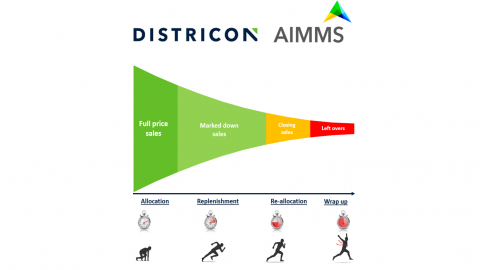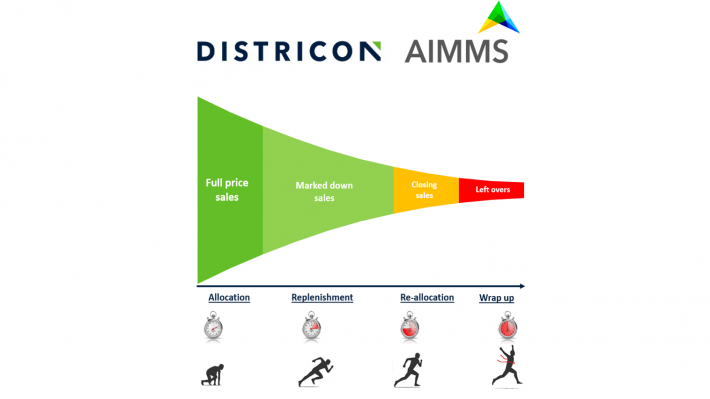
Voor het Nederlandse artikel klik hier.
Stochastic optimization is a powerful yet underrated technique which is currently not used often in practice. Introducing uncertainty in optimization models will lead to more robust and reliable solutions compared to treating everything, including uncertain components, as fixed. The consultants at Districon are familiar with these techniques and can apply them broadly with the powerful and flexible AIMMS software. By applying stochastic optimization more often, companies can prepare for the future, rather than react to it when it has become the past.
Typical for stochastic optimization problems is that they look beyond the here-and-now. Their scope covers multiple stages: time periods in which uncertain events take place. The difficulty of stochastic optimization lies in the decision making, done at the beginning of a stage. A decision can only be based on events which have occurred in the past stages, while uncertain future events will eventually determine the outcome. An intuitive example is the decision of production capacity given sales forecasts.
Fashion retailer: a business case
An indicative business case in which stochastic optimization has successfully been applied concerns a fashion retailer. This retailer replenishes her stores on a daily basis in order to maximize profit. Two key drivers determine profit: sales and margin. These in turn depend on how many items are left over at the end of the selling season and the magnitude and timing of the mark downs. Important characteristics of fashion retailers are that a collection sells in only 2-3 months, it has a limited amount of inventory and stores need both presentation- and sales stock, which have different sales profiles. Given this context a (merchandise) planner needs to optimize which stores get replenishment with which specific items on a daily level. The sales funnel is like a sprint, each collection a new race (see Figure 1).

This decision making process is strongly impacted by volatile demand forecasts. Stochastic optimization is key in this process and will lead to more robust outcomes compared to decisions made while ignoring the stochasticity, demand (or sales) in this case. Allocating a new collection over the stores and replenishing it during the sales season is a complex task. Optimization models will help planners to improve their planning quality. If these models are able to cope with the uncertain demand and adjust replenishment decisions on-the-go, even better solutions are guaranteed. The ultimate goal is to match demand and stock as good as possible, since overstock leads to mark-downs and lower margins, and understock leads to lost sales.
In this specific case of a fashion retailer, products have short lifetimes and selling seasons are relatively short and independent of each other. This amplifies the solution quality: being able to plan your production accurately and to design the sales funnel well will pay off every season again. Markets in which product lifecycles are longer will recognize the importance – and difficulty – of an accurate production planning, and may face other, maybe similar, stochastic difficulties at the tactical level.
AIMMS software
Districon uses the stochastic programming library build in the AIMMS software. This library directly integrates the stochastic behavior in your optimization model. AIMMS is a powerful and intuitive modelling and optimization platform. With AIMMS we create custom optimization solutions for specific supply chain problems across a broad range of functional areas. These AIMMS solutions are integrated with your systems and with your business processes, empowering you and your team to take optimal decisions via the intuitive user interface.
Examples of our solutions are Warehouse 3D slotting, Advanced Planning and Scheduling (APS), network design, Supply Chain Planning (SCP), retail allocation and S&OP.
Wider applicability
Additional to the example of the fashion retailer, stochastic optimization can be applied to a wide range of optimization problems, including:
- Integrating demand uncertainty for more robust production planning and scheduling;
- Inclusion of regional price development (e.g. labour, rent, fuel, transport lanes) for tactical/strategic network design topics
- Modelling financial risks in, for example, S&OP processes
Interested?
Curious about how Districon can assist your organization in solving similar questions? Please contact Richard Hornstra or Sander van Lokven.
